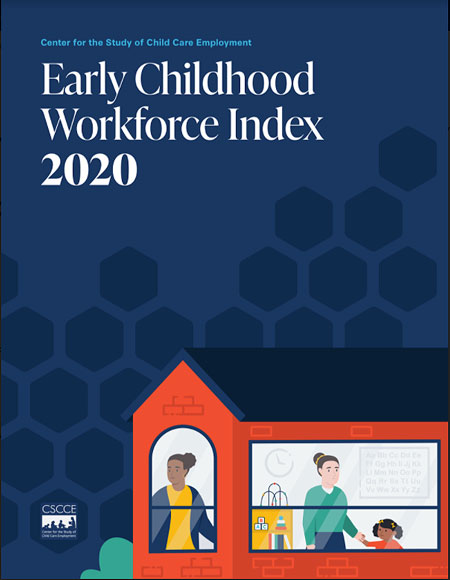COVID-19 is ravaging U.S. early childhood education, new report finds
New policies, investments needed to support critical services, Berkeley authors say
February 23, 2021

Child care and early childhood education centers have faced severe challenges during the COVID-19 pandemic, from reduced enrollments to higher costs for cleaning and maintenance. A new report from the UC Berkeley Center for the Study of Child Care Employment details how the pandemic is aggravating long-term financial stresses that have plagued school owners and workers. (Photo by Brittany Hosea-Small)
The U.S. child care system is collapsing under the pressures of the COVID-19 pandemic, with tens of thousands of low-paid workers losing their jobs and hundreds of centers forced to close or scale back operations, according to new report from the UC Berkeley Center for the Study of Child Care Employment (CSCCE).
Nationwide, in just the first six months of the pandemic last year, that industry shrank by 20%, with nearly 200,000 child care workers losing their jobs, reports CSCCE’s latest biennial “Early Childhood Workforce Index.” The report, released today, warns that the collapse will likely continue without public investment and fundamental policy reform.
“Even as many providers try to keep their doors open to ensure their financial security, the combination of higher costs to meet safety protocols and lower revenue from fewer children enrolled is leading to job losses and program closures,” the authors wrote. “Many of these closures and lost jobs are expected to become permanent.”

The UC Berkeley Center for the Study of Child Care Employment has produced the index biannually since 2016.
And, they said, the losses disproportionately affect women — especially women of color — who make up much of the child care workforce. Previous CSCCE research has shown that women of color and those working with infants and toddlers face distinct wage penalties.
A CSCCE report last year described the crippling impact of COVID-19 on child care and early childhood education centers in California. The new index makes clear that the challenges are national in scope.
“The stakes are high,” said CSCCE Director Lea Austin, a co-author of the 2020 index. “Chronic underinvestment in child care is harming working mothers, it’s harming the women who are doing this work, and it will drive greater economic hardship for everyone.”
Even before the pandemic, the index found, progress toward better compensation had been limited and uneven across states and among different classifications of early educators. Child care workers earn a national median wage of just $11.65 an hour for a job that is critically important not just to children and their parents, but to the entire U.S. economy.
Few employees want to remain in the field “because the salary and compensation package is so low,” said Davina Woods, director of Excel Christian Academy in Burlington, N.C. “By county standards, we’re paying very well, and yet, I have members of my team that receive food stamps. Out of the 14 full-time staff that are a part of my team, five of them have second jobs at places like Target.”
Essential work — with poverty wages
The findings show that many child care workers number among America’s working poor, with wages too low to make ends meet.
For single adults working in child care, pay falls short of a living wage in a majority of states. For single adults with one child of their own, the median wage is not enough to live on in any state.
As a result, the authors found, early childhood educators experience poverty at nearly eight times the rate of colleagues who teach kindergarten through eighth grade.
“Despite their important, complex labor, early educators’ working conditions undermine their well-being and create devastating financial insecurity well into retirement age,” the report found. “These conditions also jeopardize their ability to work effectively with children.”
The Early Childhood Workforce Index shows the lack of action by most states to ensure that early educators earn a living wage. In California, for example, the state budget earmarks funds toward professional development, but does not address poverty-level wages, which will continue to drive qualified teachers out of the profession and do nothing to reduce the closures of child care facilities.
“Early educators’ poor working conditions are not inevitable, but a product of policy choices that have typically let down the women and men who are doing this essential work,” said co-author Caitlin McLean, a senior research specialist at CSCCE.
Among the policies recommended by the index:
- Invest in direct public funding to provide early educators with a living wage, health care, and safe and supportive work environments.
- Prioritize improved compensation as an essential component for the post-pandemic rebuilding of the early care and education system, targeting wages/salaries, as well as health insurance, retirement plans and other benefits. Those benefits should be paid to workers both in child care centers and in home-based centers.
- Improve compensation by setting local or statewide wage and benefit standards to address wage inequity. Standards should account for job role, experience and education levels, with a goal of parity with similarly qualified elementary school teachers.
The report is based on the latest data from the U.S. Bureau of Labor Statistics and includes interactive maps and detailed tables on state workforce policies, initiatives and wages. It offers guidance to advocates, states and the federal government on priority policy areas.
CSCCE published the first index in 2016 and the second in 2018. Rich in data and narrative description, it is one of the nation’s leading sources of insight into the function and health of the nation’s child care and early childhood education systems.
The Center for the Study of Child Care Employment conducts research and policy analysis focused on achieving public investments that enable the early childhood workforce to deliver high-quality care and education for all children. CSCCE is a project of the Institute for Research on Labor and Employment (IRLE) at UC Berkeley.